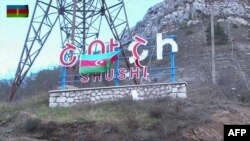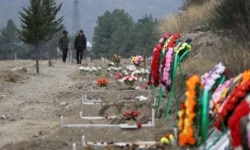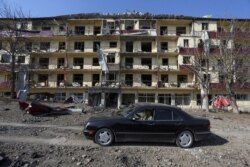Russia announced it had brokered a lasting cease-fire deal between Armenia and Azerbaijan over the disputed Nagorno-Karabakh territory early Tuesday — the Kremlin’s latest attempt to end six weeks of intense fighting in the south Caucasus that risked pulling both Russia and Turkey directly into the conflict.
“The achieved agreement created the necessary conditions for a long-term and full format settlement of the crisis around Nagorno-Karabakh on a just basis and in the interests of the Armenian and Azerbaijani people,” said Russian President Vladimir Putin in a video address early Tuesday.
Yet there was little doubt the agreement solidified gains by the Azerbaijani military — whose larger military force has been strengthened further by advanced weaponry and support from its ally, Turkey.
The deal’s key provisions call for the complete withdrawal of Armenian forces and the immediate deployment of Russian peacekeepers to the territory.
While the status of Nagorno-Karabakh — an ethnically Armenian enclave inside Azerbaijan — remains unaddressed, Armenia agreed to return to Azerbaijan portions of land seized during an earlier fight over the territory in the early 1990s that killed 30,000 and displaced more than one million people.
“I personally made a very hard decision for me and all of us,” wrote Armenian Prime Minister Nikol Pashinyan in a Facebook post announcing he had signed the deal.
“The text of the statement that has already been published is unbelievably painful for me and our people.”
“It’s not a victory, but there’s no defeat,” added Pashinyan, calling the deal “the best solution in the situation.”
The leader of the Nagorno-Karabakh territory, which Armenians call Artsakh, said Pashinyan was simply bowing to reality after Azerbaijani gains brought their forces within artillery striking distance of the self-proclaimed republic’s capital city of Stepanakert.
“Over the course of 43 days, we lost the Fizuli region, the Jabrayil region, the Qubatlu region, the Zangelan region, the majority of the Hadrut region, parts of the Martuni and Askeran regions, and Shushi, said the republic’s president, Arayik Harutyunyan, in comments carried by the Armenian news service, Aravot.
“Battles were taking place only 2-3 kilometers away from the gates of Stepanakert, but if military operations continued with the same force, we would’ve lost all of Artsakh within a matter of days.”
Dancing in Baku, anger in Yerevan
Crowds waved flags and celebrated in the streets of the Azerbaijani capital, Baku.
In addition to the Azerbaijani territorial gains, the deal amounts to an opportunity for thousands of ethnic Azeris displaced from the territory more than a quarter century ago to return home.
Azerbaijan’s president, Ilham Aliyev, said the deal amounted to "capitulation" by Armenia and openly taunted Prime Minister Pashinyan for suggesting Yerevan would never give up its quest to retake the Nagorno-Karabakh territory.
“There’s not one word on that document about the status of Nagorno-Karabakh,” said Aliyev in televised comments about the cease-fire.
“And what, Pashinyan? Where’s your status? Your status has been sent to hell.”
Meanwhile, in the Armenian capital, Yerevan, protesters stormed a government building in anger over the deal.
Photos shared on social media Tuesday showed riot troops guarding government buildings.
A helicopter downed, then peacekeepers deployed
The Russia-brokered agreement came just hours after Azerbaijan acknowledged its forces had accidentally downed a Russian helicopter operating in Armenia, killing two Russian servicemen and raising questions about how the Kremlin would respond.
Russia has a mutual defense pact with Armenia that has repeatedly raised concerns it may get pulled into the conflict despite maintaining good relations with Azerbaijan.
Yet a Kremlin spokesman maintained that the helicopter incident had not influenced the talks.
By midday Tuesday local time, Russian peacekeepers were en route to the region, where they would begin a five-year presence, even as questions lingered over whether the mission would be theirs alone.
Media reports in Azerbaijan said President Aliyev and Turkish President Recep Tayyip Erdogan were discussing Turkish forces also taking part in the peacekeeping operation.
If true, the move was all but certain to be seen as provocative by Armenians, who accuse Turkey of carrying out a campaign of genocide against them during World War I.
Yet observers in Moscow said the Turkish demands reflected its growing influence over the Caucasus region, at Russia’s expense.
“For 20 years Russia pretended they were the only power in the south Caucasus — arming both sides to preserve the balance of power,” said military analyst Alexander Goltz in an interview with Echo of Moscow radio.
“But then a new player came in” added Goltz, who argues the Kremlin-backed peace deal was “the best of bad options” to keep Russia a player in the region.
The war that never went away
Fighting between Armenia and Azerbaijan broke out on Sept. 27 - the latest in a long-simmering conflict that erupted amid the collapse of the Soviet Union and birth of national independence movements.
Nagorno-Karabakh declared its independence in 1994 but has always been regarded as formally part of Azerbaijan by the international community.
A 1994 internationally negotiated cease-fire froze the conflict but failed to bring a lasting peace.
Religion has also played a role, with Armenians largely Christian and Azerbaijanis predominately Muslim.
Over the years, both sides have engaged in skirmishes and breached the cease-fire, with dead and casualties to show for it.
It is not clear exactly how many have died in the latest fighting. Both sides have accused the other of wantonly targeting civilians.









